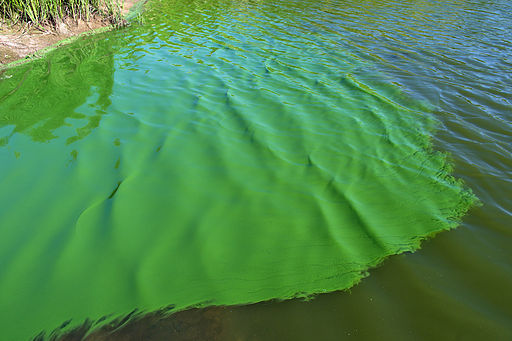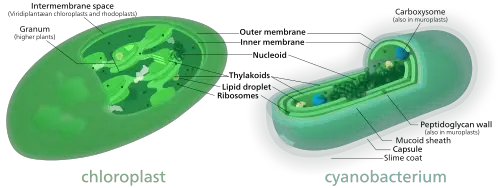Schizophyta
Blue-Green Algae
Examples, Characteristics, Morphology
Definition: What is Schizophyta?
Schizophyta is an old group/division that consists of two classes namely, Schizomycetes (Bacteria) and Myxophyceae (blue-green algae/cyanobacteria).
Under the new taxonomic classification, Schizophyta is referred to as cyanophyta and consists of blue-green algae (Myxophyceae). This article will, therefore, focus on the characteristics of Myxophyceae as representatives of Schizophyta.
Members of this group include:
- Chroococcales
- Nostocales
- Synechococcales
- Prochlorophyta
Overview
Unlike the name suggests, blue-green algae are not algae. Rather, they are a type of bacteria known as cyanobacteria. Like bacteria, these organisms are prokaryotes and are widely distributed in the environment (they can be found in aquatic environments and in soil).
Unlike other bacteria, however, blue-green algae are capable of photosynthesis and can therefore make their own food.
They are divided into four main groups that include:
- Unicellular forms
- Colonial forms
- Pleurocapsular cyanobacteria
- Filamentous forms
Ecology
As mentioned, blue-green algae are widely distributed in nature and can be found in a variety of habitats. For instance, they can be found in freshwater and marine environments, hot springs, desert soils, and estuarine mud, etc.
In certain habitats (e.g. desert soils and mud) some species make up the majority of vegetation and appear to be the most successful organisms.
In other habitats, they have been shown to be the only organisms growing. A good example of this is colonies of Nostoc commune that grow in shallow pools consisting of limestone.
Some of the other environments in which blue-green algae have been found include:
- Saline lakes
- Environments with heavy metals
- Rocks
- Sewer
* In natural water, blue-green algae play an important role in recycling nutrients.
Major groups of Blue-Green Algae
Unicellular forms (Chroococcales or Coenobia) - Examples of blue-green algae in this group include Gloeothece, Synechococcus and Gloeobacter violaceus among others. When viewed under the microscope, they may appear as individual cells or as aggregates.
Whereas some are rod-shaped, others are spherical (coccoid) in shape.
Pleurocapsular forms (Chamaesiphonales) - Like unicellular forms, this group also consists of unicellular blue-green algae. However, they are characterized by the fact that they multiply through fission.
Examples of blue-green algae in this group include Myxosarcina and Pleurocapsa.
Filamentous blue-green algae - Filamentous forms of cyanobacteria are divided into two main groups. These include; those without heterocyst and those with heterocyst. Filamentous forms are characterized by thread-like cell aggregates and a gelatinous sheath surrounding their surface. Their growth is intercalary and they move by gliding.
* As common components of periphyton, blue-green algae are responsible for the crusts and films formed over rocks (as epilithon), plants (as epiphytes), sand (as epipsammon), and sediments (as epipelon) among others.
Schizophyta Morphology and Structure
Like other bacteria, cyanobacteria are prokaryotic organisms and therefore lack a nuclear-bound nucleus and internal membrane systems. They are also characterized by a peptidoglycan cell wall typically found in various gram-negative eubacteria.
In some species, this layer is covered by an outer membrane consisting of lipopolysaccharides and can excrete soluble slime in the form of exopolysaccharides over the surface of the cell.
Given that they are capable of synthesizing their own food, all cyanobacteria contain chlorophyll a within thylakoid membranes. Within the cells, these apparatus (thylakoids) may be aligned parallel to the cytoplasmic membrane or appear coiled near the protoplasmic space. Apart from chlorophyll a, thylakoid membranes also contain beta carotene and oxo-carotenoids.
* A majority of these cells also contain blue phycobiliproteins phycocyanin and allophycocyanin that give them their blue-green color appearance.
* Some species contain phycobiliprotein phycoerythrin that gives the cell a red or black appearance and also play an important role of guiding light (involved in transferring solar energy to the photosynthetic centers of energy)
Some of the other components of these cells include:
- Circular DNA in multiple copies
- Storage bodies (e.g. glycogen granules, cyanophycin granulescarboxysomes, and polyphosphate granules)
- Gas vacuoles - Made up of protein subunits and contain gas diffusing from their environment thus providing buoyancy
Reproduction
Binary Fission
Binary fission is the most common method of reproduction among unicellular Schizophyta cyanobacteria. It's a simple process of reproduction that involves the cell splitting into two daughter cells.
This process of cell division occurs under the right/favorable environmental conditions and starts with the copying of genetic material.
This material (DNA) is then divided and segregated to the opposite poles of the cell. Components of the cell division machinery (e.g. protein FtsZ) then assemble at the central part of the cell and influence cytoplasm division before the cell separates into two.
Every step involved in the division (DNA segregation, division of the cytoplasm, and invagination of the membrane) is tightly regulated and ultimately produces two similar daughter cells.
Baeocyte Production
In some species (e.g. Stanieria), their life cycle is characterized by baeocyte production. This mode of reproduction starts with the initial growth of the cell (baeocyte).
During this growth period, the cell increases in size from about 2 um to about 30 um in diameter. As the cell matures (referred to as a vegetative cell), the DNA is repeatedly replicated as a thick extracellular matrix is produced.
This prepares the cell for the reproductive phase characterized by cytoplasmic fission and the production of numerous baeocytes. Ultimately, the extracellular matrix raptures to release the baeocytes.
Multiple Fission
This mode of reproduction is common among members of the order Pleurocapsales and produces four or more spherical daughter cells. Essentially, this process involves the rapid division of vegetative cells.
Here, the vegetative cells are formed through the enlargement of endospores. Once they grow in size, the vegetative cells cleave to form the daughter cells (endospores) that are then released through the rapture of the parental wall.
Spore Formation/Sporulation
Spore formation is common in filamentous blue-green algae (e.g. Anabaena cylindrica). Here, a thick, resistant wall develops around a vegetative cell under certain unfavorable conditions. These cells then produce spores from which vegetative cells germinate during favorable environmental conditions.
Movement
While members of the Schizophyta group lack such locomotory structures as flagella, filamentous forms have been shown to move by gliding on a solid surface.
Here, the organism moves along the surface by rotating around its longitudinal axis. This makes the fibrils (which look like threads) appear to be oscillating of swinging.
Some of the other characteristics of blue-green algae include:
- Species that form heterocyst are capable of nitrogen fixation
- Some of the species found in aquatic environments produce energy through anaerobic metabolism
- While a majority are obligate phtoautotrophs, a few are chemo-organotrophs
Return to Prokaryotes main page
Return from Schizophyta to MicroscopeMaster home
References
Hans G. Schlegel and C. Zaborosch. (1993). General Microbiology.
Karl Esser. (1982). Cryptogams: Cyanobacteria, Algae, Fungi, Lichens.
W F Vincent. (2009). Cyanobacteria.
Links
https://www.sciencedirect.com/topics/earth-and-planetary-sciences/blue-green-algae
https://www.britannica.com/science/blue-green-algae
Find out how to advertise on MicroscopeMaster!






